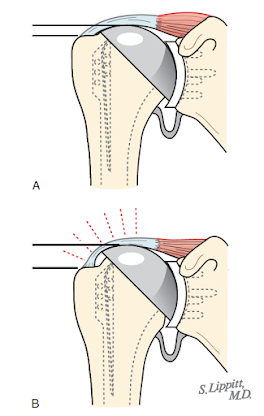A comparison of patient-specific instrumentation to navigation for conducting humeral head osteotomies during shoulder arthroplasty
These authors point out that the humeral head osteotomy during shoulder arthroplasty influences humeral component height, version and possibly neck-shaft angle. They sought to evaluate the use of patient-specific guides and surgical navigation for executing a planned humeral head osteotomy in paired 3D polylactic models created from DICOM images of 10 shoulders (5 normal and 5 osteoarthritic).
In one of each pair a humeral osteotomy was created using a patient-specific guide; in the second a real time navigated osteotomy was performed with an optically tracked sagittal saw.
They found no statistically significant differences between patient-specific guides and navigation for osteotomy cut height or humeral version. Navigation, however, resulted in significantly less neck shaft angle error than the patient specific guides.
Comment: Correct positioning of the humeral component is an essential component of a successful shoulder arthroplasty.

One of the most common errors is a "too-high" position, as shown below.
As shown in the examples above, too high positioning can contribute to glenoid component failure and can also result in a stiff shoulder as shown below.
as well as placing excessive tension on the rotator cuff
Too high positioning of the humeral head can result from a too high neck cut
or from failure to properly seat the component
We like to be sure that the margin of the humeral prosthesis is just below the "berm" as shown below.
We routinely make the humeral neck cut at a 45 degree angle with the long axis of the medullary canal.
This is the case if the apparent anatomic neck is in varus
or valgus
The head cut is made in 35 degrees of retroversion using the forearm of the flexed elbow as a reference. Care is taken to avoid damage to the cuff insertion from an excessively retroverted cut.
So, as can be seen from the above, the humeral neck cut is important. It can be correctly made without special jigs, 3D planning or patient specific guides by using direct observations make at the time of surgery.
Here are some videos that are of shoulder interest
Shoulder arthritis - what you need to know (see this link). How to x-ray the shoulder (see this link). The total shoulder arthroplasty (see this link). The ream and run technique is shown in this link. The cuff tear arthropathy arthroplasty (see this link). The reverse total shoulder arthroplasty (see this link). Shoulder rehabilitation exercises (see this link).
Follow on twitter: Frederick Matsen (@shoulderarth)
























